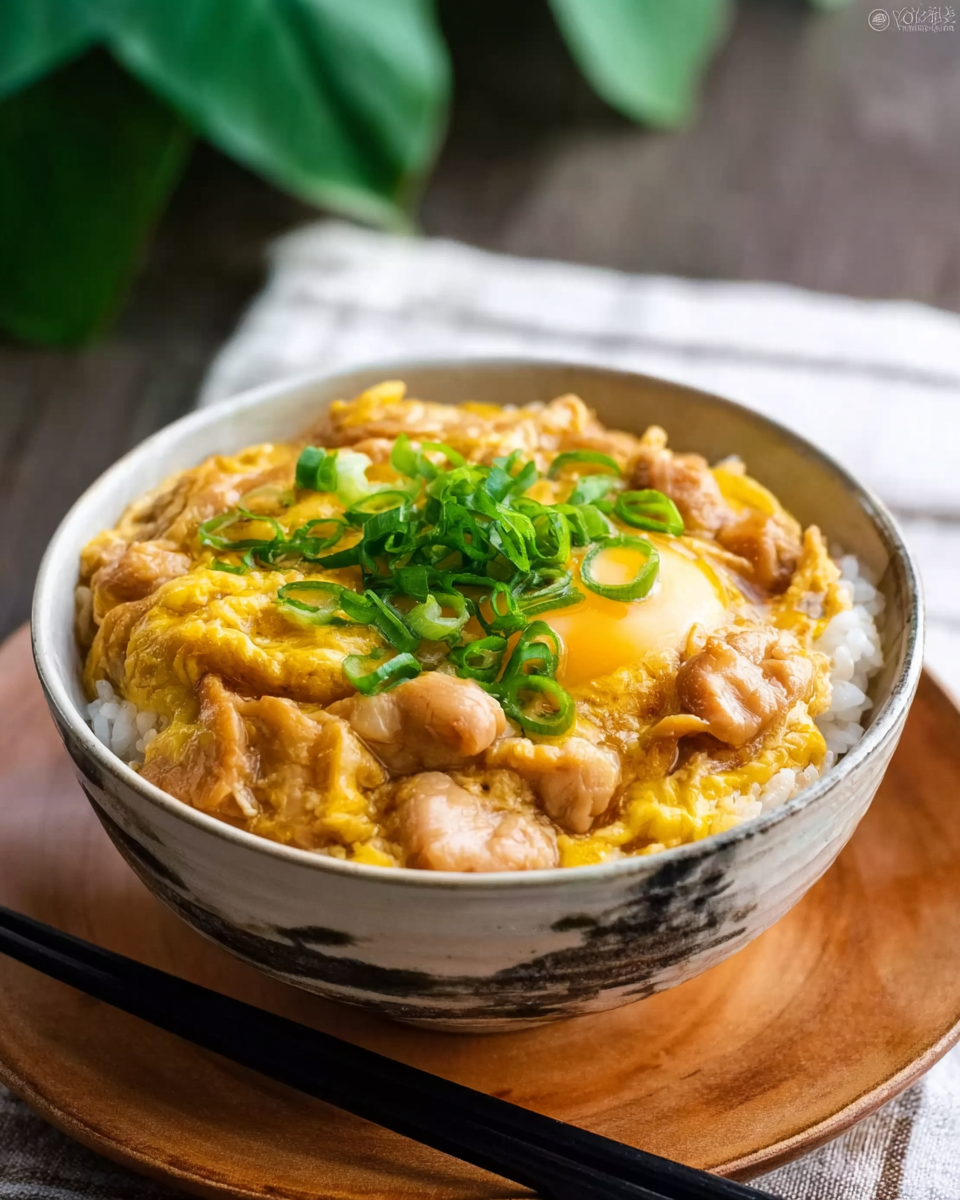The Origins and Cultural Significance of Oyakodon
Oyakodon is a dish deeply rooted in Japanese culinary tradition. Its origins trace back to the Edo period (1603-1868), a time when Japan saw a surge in the popularity of donburi, rice bowl dishes topped with various ingredients. The simple yet satisfying combination of chicken and eggs, both of which were widely accessible, made Oyakodon a beloved comfort food, especially for working-class families.
The name “oyako” (parent and child) symbolizes the inclusion of both chicken and egg in the dish. It’s said that the dish is not only symbolic of the familial bond but also reflects the comforting idea of nurturing and caring for one’s loved ones through a nourishing meal. This dish, though humble in ingredients, is considered a symbol of home-cooked meals, offering warmth and love in every bite.
In Japan, Oyakodon is often enjoyed for lunch or dinner. It’s a popular choice at home, in casual eateries, and even in convenience stores, where it’s served in a variety of ways. While the recipe remains largely unchanged, modern versions may incorporate variations like adding vegetables or seasoning adjustments, though the essence of the dish remains timeless.
Why Oyakodon is the Ultimate Comfort Food
One of the key reasons Oyakodon has become such a beloved dish is its comforting nature. The combination of tender chicken and silky eggs, paired with the rich, flavorful broth, makes it a dish that’s both hearty and soothing. When served over a bowl of warm rice, the dish becomes a complete meal, offering everything you need in one bowl: protein, carbs, and flavor.
The use of chicken thighs in this recipe adds a richness and tenderness that can’t be matched by other cuts of meat. Boneless, skinless chicken thighs are perfect for this dish because they cook quickly and remain moist throughout the simmering process, absorbing the flavors of the broth while maintaining a tender texture.
The eggs provide a velvety, creamy contrast to the chicken, and their delicate texture adds to the overall comfort of the dish. The key to making Oyakodon truly comforting is the slow simmering of the eggs, which results in soft, slightly runny eggs that envelop the chicken and onions in a savory sauce.
The Sweet-Savory Balance: Soy Sauce, Mirin, and Sugar
A hallmark of Oyakodon’s flavor profile is its sweet and savory balance, achieved through a combination of soy sauce, mirin, and sugar. Soy sauce provides the umami and saltiness that are essential in Japanese cooking, while mirin—a sweet rice wine—adds a subtle sweetness and depth. The sugar helps balance out the savory flavors and enhances the natural sweetness of the onions and chicken.
The key to getting the perfect balance between these flavors is careful simmering. The chicken, onions, and eggs all cook in this broth, absorbing the sweet-savory notes of the sauce, and creating a rich, flavorful base. The result is a well-rounded broth that’s rich without being overwhelming, offering the perfect complement to the chicken and eggs.
Mirin, in particular, plays a significant role in achieving the dish’s delicate sweetness. It adds a slight tang that cuts through the richness of the chicken, providing a balanced contrast that ensures the dish doesn’t become too heavy or overly sweet.
The Role of Chicken in Oyakodon
Chicken is the heart of Oyakodon, and it’s crucial to select the right cut for this dish. Skinless, boneless chicken thighs are ideal because they are tender, juicy, and cook quickly. They also hold up well in the simmering broth, absorbing the flavors of the sauce without becoming dry. Unlike chicken breast, which can dry out when cooked quickly, thighs maintain their moisture, adding richness to the dish.
The chicken is simmered in a flavorful broth made from soy sauce, mirin, sugar, and chicken stock or dashi (a Japanese broth made from fish and seaweed). The chicken absorbs the broth’s savory and sweet flavors, creating a tender, flavorful bite in every mouthful.
Another reason chicken is used in Oyakodon is its symbolic nature. As a humble, readily available protein, chicken is often used in Japanese cuisine to represent home-cooked meals and familial bonding, aligning perfectly with the essence of the dish.
Eggs: The Creamy, Velvety Finish
The eggs in Oyakodon are not just an ingredient—they are the defining feature of the dish. Lightly scrambled and poured over the simmering chicken, the eggs cook gently in the broth, resulting in a creamy, velvety texture that adds a rich, smooth finish to the dish.
The delicate nature of the eggs is one of the reasons Oyakodon is such a comforting dish. They don’t overwhelm the other ingredients but instead meld seamlessly with the chicken and onions, creating a harmonious combination of flavors and textures. The eggs add a silky quality to the broth, making each bite feel indulgent without being heavy.
Getting the eggs just right is essential to Oyakodon’s success. They should be cooked gently, so they remain soft and slightly runny, contributing to the overall creamy texture of the dish. When the eggs are slightly undercooked, they add a lusciousness to the broth, making it even more comforting.
Serving Oyakodon: The Perfect Bowl of Comfort
Oyakodon is traditionally served over a bowl of steamed rice, which acts as the perfect vehicle to soak up the flavorful broth. The warm rice complements the richness of the chicken and eggs, providing a satisfying base that enhances the overall meal. The combination of the tender chicken, soft eggs, and savory broth, all resting on a bed of rice, makes Oyakodon the ultimate comfort food, perfect for a filling, hearty meal.
The dish is often garnished with green onions, sesame oil, nori (seaweed), or togarashi (a Japanese spice mix), which add additional layers of flavor and texture. These garnishes add a touch of freshness, spice, or crunch, balancing the richness of the chicken and eggs.
Oyakodon Variations and Customization
While the traditional version of Oyakodon sticks to the basic ingredients of chicken, eggs, onions, and rice, there are several ways to customize the dish. Some variations include adding vegetables like mushrooms, spinach, or bell peppers to the broth for added nutrition and flavor. Others may use ground chicken or even beef instead of chicken thighs, depending on personal preference.
For a more intense flavor, you can increase the amount of soy sauce or mirin in the broth, or add a dash of chili oil for some heat. Oyakodon is a versatile dish that can be adjusted to suit different tastes, making it an easy dish to personalize.
Conclusion: A Quick and Satisfying Meal
Oyakodon is the epitome of Japanese comfort food. With its tender chicken, creamy eggs, sweet-savory broth, and warm rice, it’s the perfect meal to nourish both body and soul. Whether you’re preparing it for a quick weeknight dinner or serving it for a more special occasion, Oyakodon is a dish that is sure to satisfy.
This dish’s appeal lies in its simplicity and versatility. It’s quick to prepare, taking just about 15 minutes from start to finish, yet it delivers a meal that feels wholesome and comforting. The rich, savory flavors, combined with the softness of the eggs and the tender chicken, create a balanced meal that can be easily customized to suit your tastes. Oyakodon is more than just a meal—it’s a nourishing bowl of comfort that brings warmth and satisfaction to your table.






